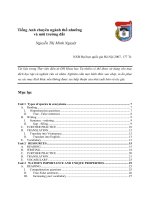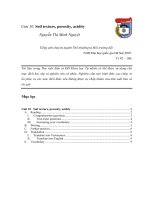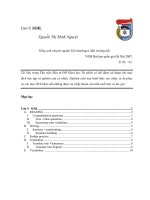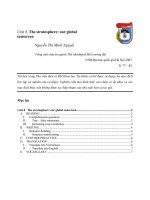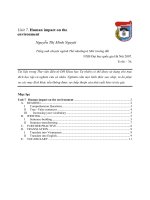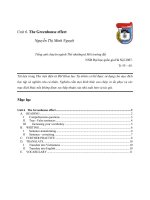Tiếng anh chuyên ngành Thổ nhưỡng và Môi trường đất phần 9 docx
Bạn đang xem bản rút gọn của tài liệu. Xem và tải ngay bản đầy đủ của tài liệu tại đây (201.81 KB, 11 trang )
Tiếng anh chuyên ngành Thổ nhưỡngvà Môi trường đất
NXB Đại học quốc gia Hà Nội 2007.
Tr 83 – 91.
Tài liệu trong Thư viện điện tử ĐH Khoa học Tự nhiên có thể được sử dụng cho mục
đích học tập và nghiên cứu cá nhân. Nghiêm cấm mọi hình thức sao chép, in ấn phục
vụ các mục đích khác nếu không được sự chấp thuận của nhà xuất bản và tác giả.
Mục lục
Unit 9 SOIL 2
A. READING 2
I. Comprehension questions 3
II. True - False questions 4
III. Increasing your vocabulary 4
B. Writing 5
I. Sentence - transforming 5
II. Sentence-building 6
C. Further practice 7
D. Translation 8
I. Translate into Vietnamese 8
II. Translate into English 8
E. Vocabulary 10
Unit 9. SOIL
Nguyễn Thị Minh Nguyệt
Unit 9
SOIL
A. READING
• Warm-up Activities
- What are the components of soil?
- How many horizons of soil are there?
What is soil? Soil is a complex mixture of inorganic materials (clay, silt, pebbles, and
sand), decaying organic matter, water, air, and billions of living organisms. Soil forms when
life-forms decay, when solid rock weathers and crumbles, and when sediments are deposited
by erosion. Unless you are a farmer, you probably think of soil as dirt- something you don't
want on your hands, clothes, or carpet. Yet your life and the lives of other organisms depend
on soil, especially topsoil. To a large extent all flesh is soil nutrients. Soil also provides us
with wood, paper, cotton, medicines-everything we get from plants-and helps purify the water
we drink. Yet since the beginning of agriculture we have abused this vital, potentially
renewable resource. Entire civilizations have collapsed because they mismanaged the topsoil
that supported their populations.
Mature soils are arranged in a series of zones called soil horizons, each with a distinct
texture and composition that varies with different types of soils. A cross-sectional view of the
horizons in a soil is called a soil profile. Most mature soils have at least three of the possible
horizons.
The top layer, the surface-litter layer or O-horizon, consists mostly of freshly fallen and
partially decomposed leaves, twigs, animals waste, fungi, and other organic materials.
Normally it is brown or black in color. The- topsoil layer, or A- horizon, are a porous mixture
of partially decomposed organic matter (humus) and some inorganic mineral particles. Usually
it is darker and looser than deeper layers. The roots of most plants and most of the soil's
organic matter are concentrated in these two upper layers. As long as these layers are anchored
by vegetation, soil stores water and releases it in a nourishing trickle instead of a devastating
flood.
The two top layers of most well-developed soils teem with bacteria, fungi, earthworms,
and small insects. These layers are also home for burrowing animals such as moles and
gophers. These soil-dwellers interact in complex food webs.
Bacteria and other decomposer microorganisms are found by the billions in every handful of
topsoil. They recycle the nutrients we and other land organisms need by breaking down some of
the complex organic compounds in the upper soil into simpler inorganic compounds soluble in soil
water. Soil moisture carrying these dissolved nutrients is drawn up by the roots of plants and
transported through stems and into leaves.
Some organic litter in the two top layers is broken down into a sticky, brown residue of
partially decomposed organic material called humus. Because humus is only slightly soluble
in water, most of it stays in the topsoil layer. A fertile soil, producing high crop yields, has a
thick topsoil layer with lots of humus. Humus also helps topsoil hold water and helps keep
nutrients taken up by plant roots from being carried away as rainwater percolates downward
through the topsoil.
(Taken from "Sustaining the Earth" by Tyler Miller, G)
I. Comprehension questions
Answer the following questions
1. How does soil form?
2. What does soil give us? When did people start to abuse soil?
3. Why haven't we succeeded in civilizing?
4. When are mature soils called soil horizons? How many possible horizons do they have?
5. What are two top layers? What are there in these top layers?
6. What does the topsoil layer consist of?
7. Where can soil-dwellers interact?
8. How do bacteria and other decomposer microorganisms recycle the nutrients?
9. Why does most of humus stay in the topsoil layer?
10. Which soil can produce high crop yields?
II. True - False questions
Decide whether the following statements are true "T" or false "F". Correct the false
statements.
1. Neither our life nor the lives of other organisms depend on topsoil.
2. Not all mature soils have at least three of the possible horizons.
3. Soil can not be used again. It is used once only.
4. Only mores and gophers live in A-horizon.
5. The composition of the surface-litter layer is quite different from that of the
topsoil layer.
6. We can find only one or two billion of bacteria and other decomposer
microorganisms in every handful of topsoil.
7. Because of having a thick topsoil layer with lots of humus, a fertile soil
produces high crop yields.
8. The color of the deeper layer is not so dark as the topsoil layer.
9. Some living organisms are found in soil.
10. One of the characteristics of humus is to help topsoil hold water.
III. Increasing your vocabulary
Synonyms
Find words or phrases in the text that can be replaced by the following:
1. complicated
2. composition
3. mixture of two or more things
4. act on each other
5. use again and again
6. fully developed
7. full of pores
8. overwhelming
9. matter deposited on the land by water or wind
10. advanced stage of social development
Gap-filling
Complete the following statements with one of the appropriate words given bellow.
topsoil soil horizons living organisms
inorganic materials the surface-litter layer horizons
soil profile organic matter the topsoil layer
soil-dwellers food webs mature soils
1. Soil is a mixture of (1) , decaying (2) , water, air and billions of
(3)
2. Mature soils are arranged in a series of zones called (4)
3. Your life and the lives of other organisms depend on soil, especially (5)
4. A cross-sectional view of the horizons in a soil is called (6)
5. The top-layer, (7) ,consists mostly of freshly fallen and partially decomposed
leaves, twigs, animal waste, fungi and other organic materials.
6. (8) is a mixture of partially decomposed organic matter and some inorganic
mineral particles.
7. Most (9) have at least three of the possible (10)
8. The (11) interact in complex (12)
B. Writing
I. Sentence - transforming
Finish each of the following sentences in such a way that it means the same as the
sentence printed before it.
1. Unless you are a farmer, you probably think of soil as dirt.
If you are
2. The surface-litter layer is brown or black in color.
The color of
3. The topsoil layer is darker and looser than the deeper layers.
The deeper layer
4. The two top layers of most well-developed soils teem with bacteria, fungi, earthworms,
and small insects.
There are
5. A fertile soil producing high crop yields has a thick topsoil layer with lots of humus.
A soil which
6. If a soil is too dry, the seeds will not germinate.
Unless
7. When the young plant break the soil surface, food manufacture by photosynthesis can
begin.
When the soil surface
II. Sentence-building
Make any changes and additions to complete the following sentences from the prompts
given bellow.
8. Too much / cultivation / destroy / soil structure.
9. The plant / produce / food / chemical substances / present / soil / air.
10. We / can / use a unit / called / soil profile / describe / soils.
11. When / we / want / compare / two soils, / we / examine / profiles.
12. The root hairs / be / part / a plant / which / absorb / water / mineral / soil.
13. The temperature / wet / soils / be / lower / than / well-drained soils.
14. Seeds / can not / germinate / a soil / which / lack / sufficient oxygen.
15. It / take / century / form / 1 inch / new topsoil.
C. Further practice
Gap-filling
Read the following paragraph. Put a circle round the letter of the correct word or words
to use in each blank
1. a. passes b. used to pass c. would pass d. passed
2. a. are burning b. would burn c. have burnt d. were burnt
3. a. not used b. did not use c. not using d. was not used
4. a. doubles b. had doubled c. will double d. would double
5. a. were unable b. would be unable c. will be unable d. are unable
6. a. has declined b. will decline c. declines d. would decline
7. a. believed b. is believing c. believing d. is believed
8. a. would use b. used c. use d. will use
9. a. did not increase b. would not increase c. does not increase d. may not increase
10. a. would never use b. may never be used c. would never be used d. may never use
11. a. was b. used to be c. would be d. has been
When man first learned how to make a fire, he began to use fuel for the first time. The
fuel he used was probably wood. As time (1) , man eventually discovered that
substances such as coal and oil (2) .
Coal (3) very widely as a source of energy until the last century. With the
coming of the industrial revolution, it was soon realized that production (4) if coal
was used instead of wood. Nowadays, many of the huge factories and electricity generating
stations (5) to function if there was no coal.
In the last twenty or thirty years, however, the use of coal (6) As a result,
there have been changes in the coal industry. It (7) that more people
(8) coal if oil and gas were not so readily available.
There is more than enough coal in the world for man's needs for the next two hundred
years if our use of coal (9) . Unfortunately, however, about half of the world's coal
(10) . Mining much of it (11) very expensive even if it was possible
to use new equipment.
(Taken from "Extra Practice" by George, D)
D. Translation
I. Translate into Vietnamese
Three materials in various compositions; water (including snow), rock and soil cover the
Earth surface. Soil results from the weathering of rock materials, which involves both the
physical breakdown of rock into small particles and chemical alteration of its composition.
There are, however, many other processes, which together produce the distinctive features of
the material we call soil and organize this material into soil on the surface of the land. Of
primary importance are the processes associated with plants, animals and microorganisms,
which colonize the soil.
(Taken from "Land Use" by O’Callaghan, J.R)
II. Translate into English
1. Do các cấp hạt của đất rất nhỏ nên nước không thể ngấm qua đất một cách dễ dàng.
2. Nếu có quá nhiều nước ở trong đất thì nó phải được tháo rút.
3. Thành phần đất ở những vùng khô cằn và thành phần của đá gốc rất giống nhau.
4. Trong nhiều thế kỷ qua người ta đã nhận ra rằng, mặc quần áo màu sáng trong khí hậu nóng thì mát
hơn là mặc quần áo màu tối vì màu tối hấp thụ nhiệt nhiều hơn. Tương tự như thế, đất sẫm màu hấp
thụ nhiệt nhiều hơn đất sáng màu. Mặc dù đất tối màu có lượng mùn cao, hấp thụ nhiệt nhiều hơn
đất sáng màu, nhưng loại đất này lại thường xuyên chứa được nhiều nước hơn.
5. Môi trường đô thị ở nước ta đang bị ô nhiễm do các chất thải rắn và nước thải chưa được thu gom
và xử lý theo đúng quy định. Thêm vào đó thì khí thải, tiếng ồn và bụi từ các phương tiện giao thông
và các ngành sản xuất quy mô vừa và nhỏ cùng với cơ sở hạ tầng yếu kém càng làm cho điều kiện
vệ sinh môi trường ở đô thị lâm vào tình trạng báo động. Hệ thống cấp thoát nước lạc hậu, xống cấp,
không đáp ứng được yêu cầu. Mức ô nhiễm không khí do bụi và các khí thải độc hại ở
nhiều nơi
vượt tiêu chuẩn cho phép nhiều lần, đặc biệt ở một số thành phố lớn như Hà Nội, thành phố Hồ Chí
Minh vượt tiêu chuẩn cho phép từ 2 đến 3 lần.
E. Vocabulary
1. abuse (v) : lạm dụng
2. anchor (v) : neo, bám chặt
3. civilization (n) : sự văn minh, sự khai hoá
4. complex (adj) : phức tạp
5. compound (n) : hợp chất
6. crumble (v) : vỡ vụn
7. decay (v) : thối rữa, mục nát
8. decompose (v) : phân huỷ
9. earthworm (n) : con giun đất
10. fungus (n) : nấm
11. humus (n) : mùn cây
12. inorganic (adj) : (thuộc) vô cơ
13. interact (v) : tương tác
14. material (n) : vật chất
15. mature (adj) : trưởng thành
16. mineral (n) : khoáng chất
17. mixture (n) : h
ỗn hợp
18. mole (n) : số phân tử gam của vật chất
19. particle (n) : phân tử, hạt
20. pebble (n) : đá cuội
21. percolate (v) : ngấm
22. porous (adj) : lỗ rỗng, tính rỗng
23. purify (v) : lọc, làm cho tinh khiết
24. recycle (v) : tái chế
25. resource (n) : tài nguyên
26. root (n) : rễ cây
27. sand (n) : cát
28. sediment (n) : trầm tích
29. soil profile (n) : phẫu diện đất
30. soluble (adj) : có thể hoà tan
31. stem (n) : thân cây
32. topsoil (n) : (tầng) đất mặt
33. zone (n) : miền, vùng


